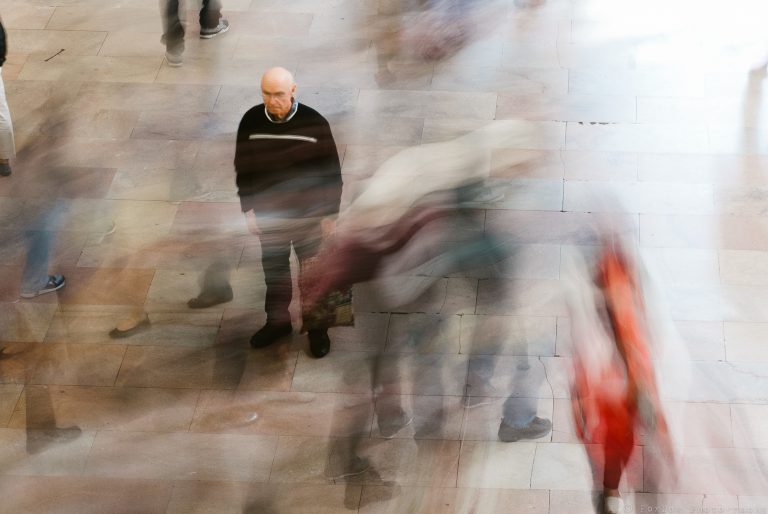
Image by Sal/Flickr, Attribution-NonCommercial-NoDerivs.
What to Do When Anxiety Overwhelms You
The overwhelm of anxiety builds and builds — as one thought generates two more thoughts, four more spring from those. The mind proliferates, taking each feeling as fact and conjecturing another frightening scenario on that, and then another. If this, then that, and then this, and this, and this, and then we all die in a raging fire.
As I travel the world teaching, my audiences frequently ask for help in stopping these rapidly escalating — and isolating — thought patterns. In this second column on anxiety, I will offer some tools for you to cope.
In my previous column on this topic, I addressed the difference between anxiety and fear. Fear is a response to an immediate threat to your safety, like coming across a bear in the forest. Your senses become alert and your muscles tense, readying you to flee. Anxiety manifests itself in the body in a similar way even though the threat that generates it arises only in the mind.
My good friend Sylvia Boorstein has thought a lot about how to handle anxiety because she suffers from it profoundly. Now in her 80s, she’s developed a number of tools to keep it at bay. She was walking through Costco recently and found herself in an aisle surrounded by big screen televisions all of which were displaying news about politics.
Instantly her pulse started to race, and all her fears for the future ricocheted inside her mind, so much so that she had to stop. Sylvia took a breath and then another to bring herself out of her mind and back to her body — in the here and now.
She was in a big public place, and she was safe. From that, she expanded her thoughts to her reliable car in the parking lot, her home where she has lived comfortably for decades. Rooting herself in the present — and in her larger context — shrunk the anxiety and thereby weakened it, allowing her to go about her errand.
Sylvia’s story illustrates two elements of coping with anxiety. The first is recognizing it. Is the threat in the moment, or is it in the mind? Once you name it, it’s easier to address it. You, like Sylvia, can reach for a number of tools.
Her story also illustrates how anxiety never goes away. Anxiety can cause anxiety! You can become anxious thinking that you should not be this anxious, so you must be crazy. Sylvia jokes that she is a “recovering catastrophizer,” but as we can see from this story, the recovery is ongoing. Even after decades of practice, she still has to stop to remind herself that she does not need to be alarmed right at that moment and that she has tools she can use.
Anxiety is high energy confined to a restricted space. One is always trying to bring a balance between energy and calm, peaceful concentration.
When I look at my own anxiety, I see it as unique. Many are made anxious by not knowing, but I am afraid of the things I believe to be certain. The plane is going to crash. My car is going to break down. Whether the anxiety comes from the certainty that we are right or the despair that nothing is going to ever work, we want to give this high energy a big space so it no longer bounces off the walls of the mind.
Worrying about something influences the outcome and may, in fact, consume the mental energy needed to respond to genuine fearful events. We cannot face the world deftly in a constant state of fear, but we also do not want to be daydreaming through life. As Sylvia says:
“To see clearly, to make wise decisions, we need a mind that has enough strength, so you do not want it fatigued with incessant worries.”
Misty, a young woman I’ve been corresponding with about anxiety, described how she decided to address her anxiety when she realized how it was wearing her out. She became a student of it: listening to podcasts and audiobooks while taking up yoga and meditation. Misty also tried mantras, another effective tool. As you rock softly murmuring, these syllables resonate through the body and soothe the spirit. Some think chanting muffles anxiety, drowning it out with rhythmic movement and phrases. That is part of it, but you can also experience how this practice releases your anxiety by putting you in harmony with yourself and your surroundings.
You aren’t going to start rocking and chanting if you have an anxiety attack in the aisle at Costco, but you can do a lovingkindness meditation, sending good wishes for all — including yourself:
May I be free from harm. May I be strong and healthy. May I be happy. May I live a life filled with ease.
Then extend those same wishes to the people you love and to the wider world. When you say those wishes sincerely, every element of the practice is a relief. The phrases channel the energy instead of allowing it to proliferate. As you do this, you are back in charge and you can feel the body relaxing as the space around your anxiety opens up and releases. When you release control, you are free to choose how to react rather than being inhibited by frightening conjectures.
Anxiety can overwhelm you at home as well, and when it does, one tool is to change your surroundings. There may be concerns at home that trigger your anxieties, and walking out the door — literally getting away from them — can give you the appropriate distance to regain control.
Sylvia sometimes walks over to the grade school near her home and watches the children playing in the yard at recess.
“I see all these little people on the jungle gym and the adults acting with such care and kindness. I am reminded that there are good people, people who are not all wigged out like me, who are operating on the assumption that these little people are going to grow up and they see a world for them. This helps me see that world too.”
Misty’s determined quest to find a way to handle her anxiety has had good results, she reports:
“Everything I was doing to be happy was all external. Now I have this inner resource of peace and happiness that is always replenishing me and nourishing me. My anxiety is now just a little bug that comes around every now and then. I simply hold out my finger for it to land on and then give it a little exhale and it flies away unhurt.”
Such a beautiful image, and something I wish for all of you who may become consumed by anxiety.
Start by taking a breath or two to ground yourself so that you can determine if the threat you feel is real or a conjecture from circumstances. Once you know that what you feel is anxiety, you can use lovingkindness, chanting, or a change in your surroundings to create space around your anxiety to reduce its power and return your mind and body to a balanced state where you can respond more skillfully to our sometimes frightening world.

Share your reflection